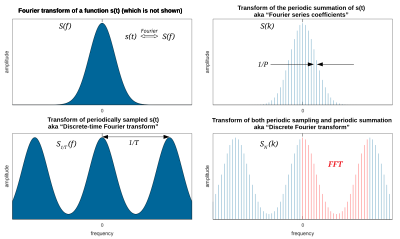
Summary
In mathematics, any integrable function can be made into a periodic function with period P by summing the translations of the function by integer multiples of P. This is called periodic summation:

When is alternatively represented as a Fourier series, the Fourier coefficients are equal to the values of the continuous Fourier transform, at intervals of .[1][2] That identity is a form of the Poisson summation formula. Similarly, a Fourier series whose coefficients are samples of at constant intervals (T) is equivalent to a periodic summation of which is known as a discrete-time Fourier transform.
The periodic summation of a Dirac delta function is the Dirac comb. Likewise, the periodic summation of an integrable function is its convolution with the Dirac comb.
Quotient space as domain edit
If a periodic function is instead represented using the quotient space domain then one can write:
The arguments of are equivalence classes of real numbers that share the same fractional part when divided by .
Citations edit
- ^ Pinsky, Mark (2001). Introduction to Fourier Analysis and Wavelets. Brooks/Cole. ISBN 978-0534376604.
- ^ Zygmund, Antoni (1988). Trigonometric Series (2nd ed.). Cambridge University Press. ISBN 978-0521358859.








